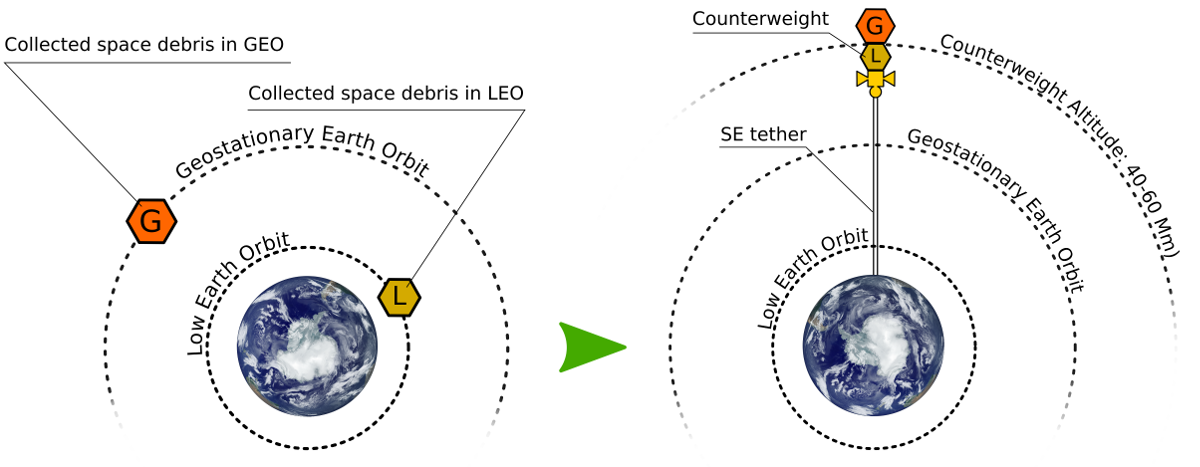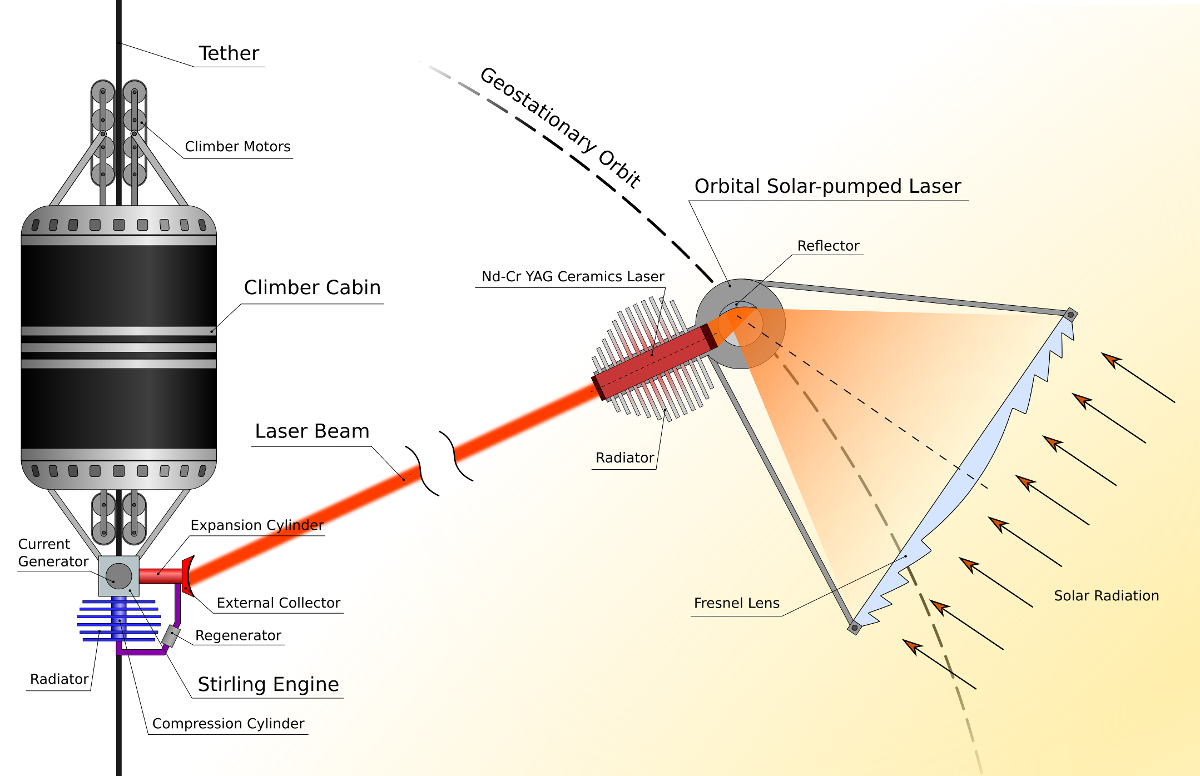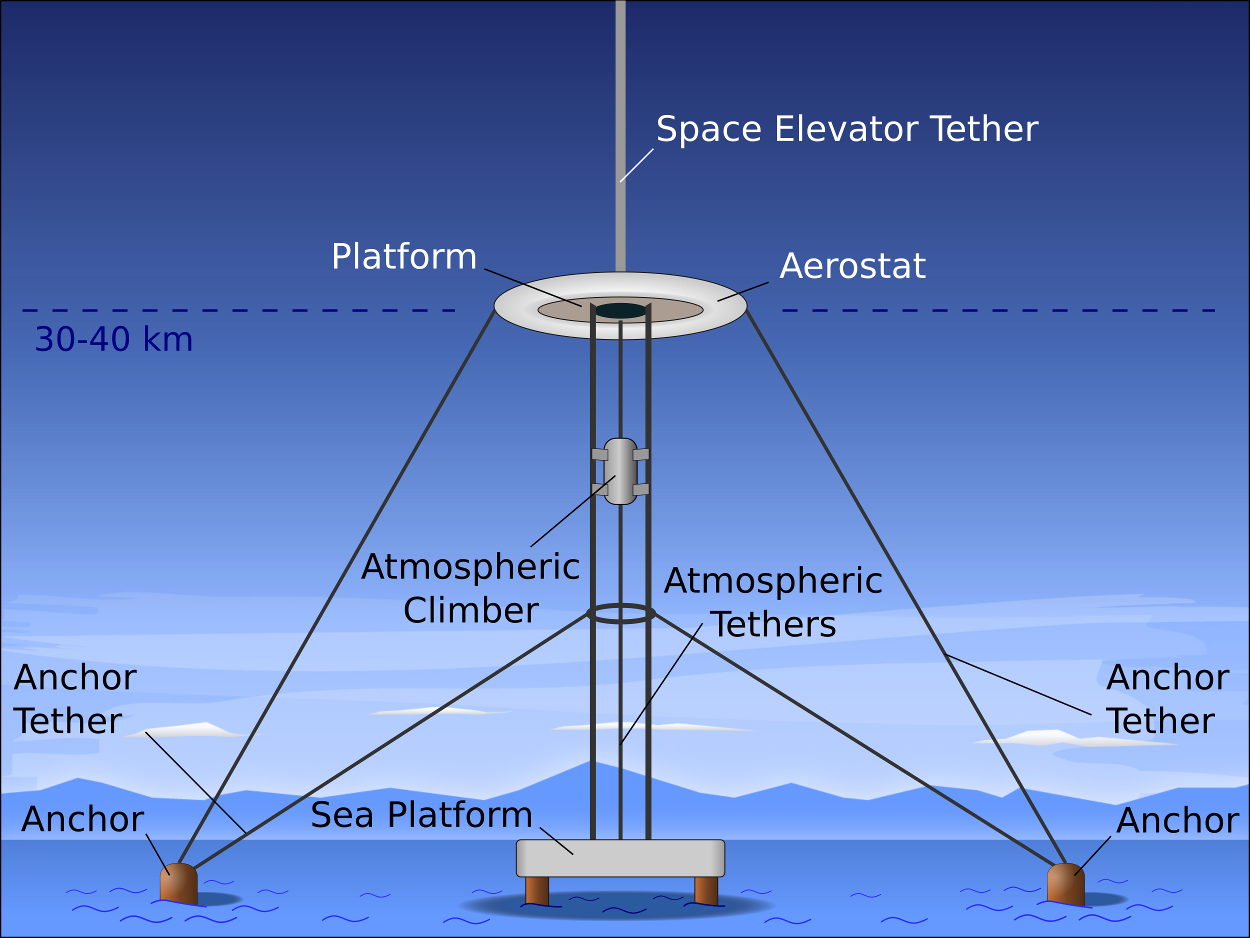Space Elevator
Space Elevator is a low-cost space transportation system that is based on the idea of stretching a long (up to 100 000 km) and ultra-strong tether (or a set of tethers) from the Earth’s surface up to space with its free end beyond the geostationary orbit. Such tether will be anchored to the land or sea platform placed somewhere near the equator. The tension in the tether is provided by two competing forces – gravity, which is stronger at the lower end, and the upward centrifugal force, which is stronger at the upper end and is caused by the Earth's rotation. The vehicles (called climbers) will move along the tether with non-rocket propulsion which will increase safety and reduce cost of space travel.
- Dr. Bradley Edwards in his book “The Space Elevator: A Revolutionary Earth-to-Space Transportation System” (2003);
- International Academy of Astronautics in the study “Space Elevators: An Assessment of the Technological Feasibility and the Way Forward” that was conducted in total by 41 authors (2013). This study is still ongoing in the frame of the IAA Study Group “Road to Space Elevator Era”;
- Obayashi Corporation in 2014, which is plans to build a space elevator by the year 2050 with a capacity to carry 100-ton climbers.
All of these concepts have the same basic vision of the Space Elevator and its key components, but with different deviations. They address main issues related to the space elevator: gravitational factors, radiation and temperature gradient, tether collision with space debris, atmospheric effects, climber powering, tether severance, and many other. Quite a few solutions to the space elevator systems have been proposed. But due to the complexity and absence of the proper material no unified concept of the space elevator has been agreed yet. As it has been mentioned in my study and verified by Dr. Swan: more conceptual research in different areas of the space elevator design is required.
My concept of the Space Elevator is aligned with the mainstream visions described in the studies listed above. It integrates different existing solutions and presents some new approaches. As for today my contribution consits of three major improvements of the Space Elevator components.
Counterweight assembled of large fragments of space debris
I introduce "green" Space Elevator with reduced tether length and increased counterweight mass assembled from the collected space debris. Despite the common convention of the 100 Mm tether I propose a twice shorter tether that will end at the altitude of 40-60 Mm. In this case a massive counterweight of approx. 5 kt is required. This is very close to the total mass of all dead satellites and launch vehicles' upper stages that will be circling in orbit by 2030.

Exoatmospheric climber feeding with GEO-based lasers
The idea of using a laser beam to transmit power to the space elevator climber is described in details in the book of Dr. Edwards. In the case of using powerful ground- or sea-based laser several serious problems emerge: continuous operation of the high-energy laser in all weather conditions, over-flight of aircraft and spacecraft, intersection of a tether with a laser beam etc. Some of these issues can be avoided by using space-based lasers, and particularly solar-pumped lasers, also analyzed by Dr. Edwards. I propose significant improvement of this idea by applying Stirling engine at the climber site to convert energy of the laser beam to mechanical energy that will be used directly to propel the climber, or will be converted to electricity to feed motor drives. The efficiency of solar-pumped lasers reaches 40% and efficiency of Stirling engine is about 30%. These two technologies can be used to build simple and robust system of feeding the space elevator climber.

Electric powering of the atmospheric climbers and aerostat-based platform
The study of International Academy of Astronautics is focused on using solar arrays tethered to the climber as the power source. The huge required area of solar arrays leads to the need of stacking and hiding them inside the aerodynamic dome while moving in the atmosphere.
I propose an alternative solution of feeding climber with electric current running in the tether up to the altitude of 40 km. In this regard at least two atmospheric tethers are required and I propose three - to use a standard 3-phased scheme. This will increase efficiency and reduce mass and cost of the electric motors used in the climber design, as well as increase tether stiffness. Some carbon fibers based on carbon nanotubes have significant electrical conductivity which is compared to the conductivity of steel. This makes the idea quite feasible.
Application of additional tethers will increase aerodynamic load on the tether which is one of the main concerns. To undo additional forces in the tether I propose to place an anchor point on the aerostat-based platform at the altitude of 30-40 km. The most rational solution is to use a torus shape for the aerostat to encircle the tether and place a platform in the inner volume. Aerostat can be anchored with additional inclined tethers. This will reduce lateral displacements of the aerostat and thus reduce tension in tethers.

More detailed description of these and other design solutions for the Space Elevator components can be found in my article "Space Elevator. Alternative Design Solutions" that was presented at IAC 2015.


